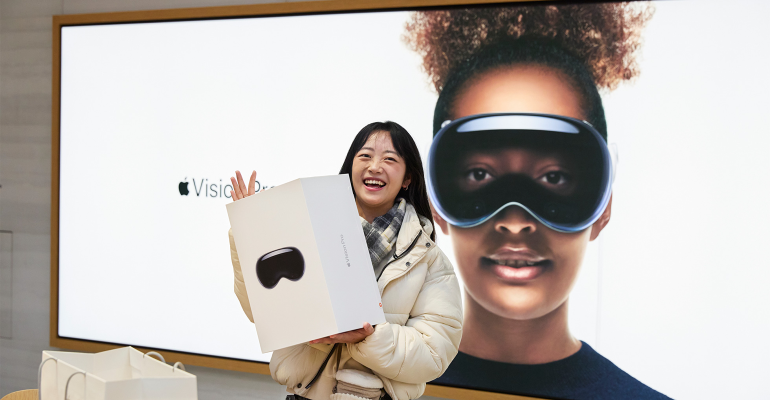Virtual Reality hardware products have been akin to flash paper. They burn real hot then quickly fizzle out, having barely scratched the surface of adoption. With the introduction of Apple Vision Pro, things are poised to change, and rapidly. The tech giant has a notable history of successfully instantiating behavioral shifts within large groups of people. Where others have failed, Apple is sure to win, and with them are the brands willing to take advantage of the moment. And restaurant brands are well positioned to do so by creating ways for consumers to immerse in the brand and order food in all new ways.
For those that do not know, Apple launched their Vision Pro, a mixed-reality headset, to the masses on January 5, and with it the advent of a new term: spatial computing. The headset is a wearable device that whisks users into a new world where eye movements and finger taps remove the need for the traditional peripheral devices like keyboards and mouses. Sure, this isn’t a new tech gadget, as other players have already attempted to spark this shift into spatial computing. So far, though, there has been little success. With Apple, we get a trustworthy brand that’s known for style and simplicity that is certain to usher in mass adoption of the hardware and mixed reality interfaces.
Apple is by no means the pioneer in this space, nor will they be the only player moving forward. But, much like the iPhone and iPad, Apple will break down the tech and usability barriers and make spatial computing palatable to mass adopters. In its wake will be the other players that create, iterate, and innovate to try to keep up. While they duke it out, we all win as our connectivity advances into all new realms.
In this sprint to better and cheaper tech, brands are poised to win out. Those that find new ways of immersing consumers in unique experiences in this new reality will drive affinity and create new revenue streams. And there is no other industry as ripe for realizing these upsides than the restaurant industry.
Restaurant brands are poised to make waves with a seemingly limitless suite of opportunities. The lowest hanging fruit for restaurant brands is to offer up ordering directly from an augmented reality interface. Crumbl Cookies has already launched their version of this. Starting with this utilitarian offering is a good idea, but that’s just scratching the surface of what could be in this new world.
Diving deeper into the possibilities, brands could look to emulate an in-store experience that’s either fully immersive virtual reality, or an augmented reality that’s activated within the physical space of the user. Imagine sitting at home on your couch and launching into a restaurant scene where you learn about the brand, buy merchandise, participate in loyalty-driven conversations, and, yes, order food. That’s all now possible, but this is a ground floor, basic path and idea.
Spatial computing opens the door to experiences that break out of the analog and even the digital confines with which we’re all familiar. For instance, ordering can be more immersive with a full 3D view of menu items. Users can build their orders and checkout with a literal blink of an eye then dig deeper into the brand’s tenets and values.
Brands that tout their commitments to sustainability can take users on a journey that show them the actual impact of their efforts. Journeys that are fully immersive, minus smell and taste, can build brand awareness and loyalty.
Then there is gaming. The mixed reality experience can make scavenger hunting a very real feeling, or a more physical game that involves movement and tasks. These can all ladder up to a brand’s values to create instant connectivity and believability in the brand.
Another idea is giving users the ability to see how food is created first hand, from the view of the chef or cook. Or how the ingredients are sourced through the eyes of the harvester, may be another path. No matter what it is, a first person experience makes people feel involved and invested which is a powerful emotion that can have high upsides for restaurant brands.
The possibilities are nearly endless, and they will continue to expand as the technology advances. Only the limitations of imagination and investment will be in the way as we march into this new era. To compound the power of the shift into spatial computing are the plans of more integrated wearable tech that we have heard of, and some that we can only imagine. Suffice to say, it’s time to start thinking in the third dimension when thinking of user experiences.
Spatial computing is set to take over the day-to-day work experience as the visual world is now all at the fingertips of a user. From calendars to conference calls, multitaskers are now the master of their domain. With this massive behavior adoption comes new need states that brands must answer. One need that every human, connected or not, will always have is the need to eat. Brands that adopt this early will win big as they become the go-to for the new tech-connected, mixed reality savants, and laypeople alike.
 AUTHOR BIO
AUTHOR BIO
Joseph Szala serves as the vice president of digital experience at branding agency 3 Owl and is the author of “The Bullhearted Brand: Building Bullish Restaurant Brands That Charge Ahead of the Herd.”

